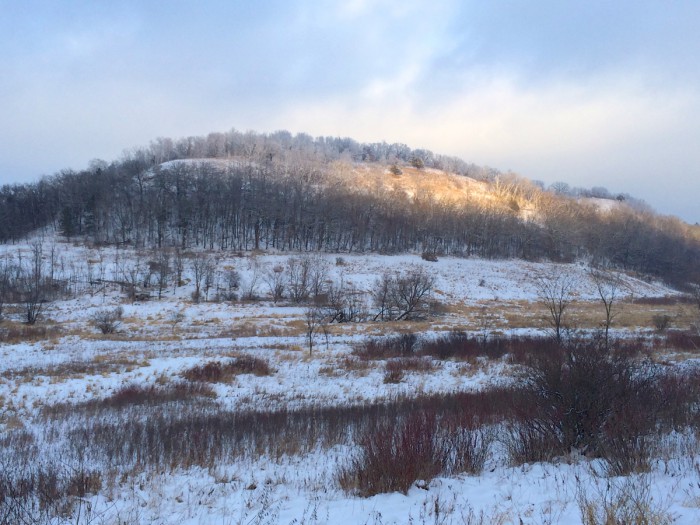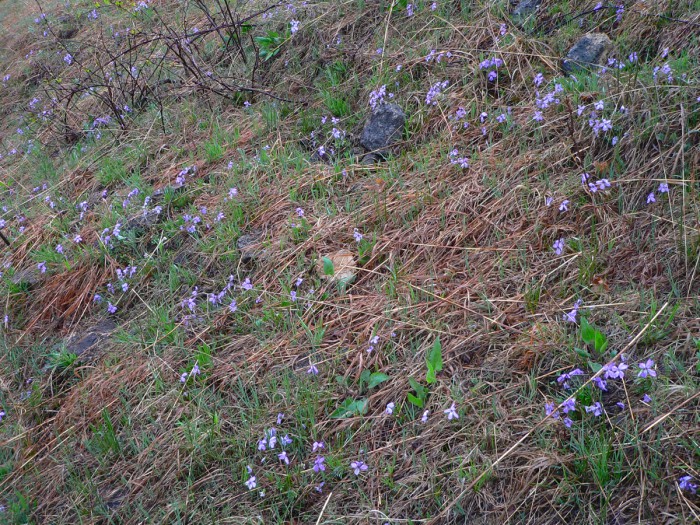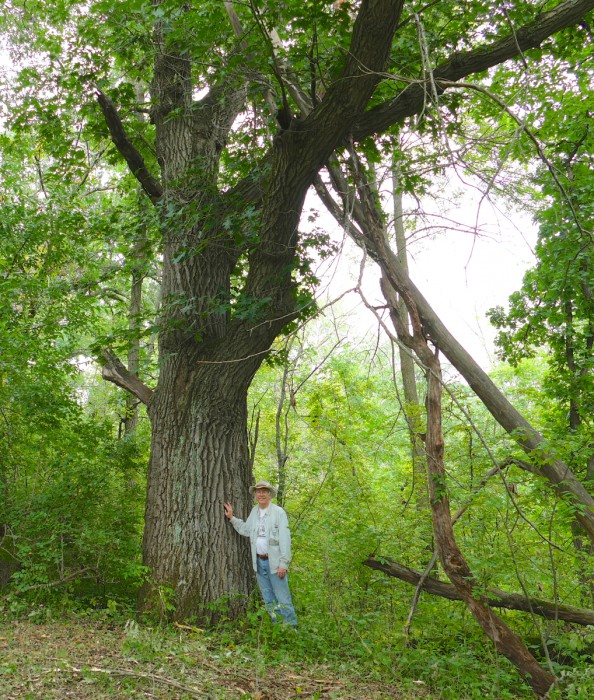This is our steepest prairie and largest remnant. It’s on our eastern bluff, and faces south. It includes two dry open prairie areas, surrounded by overgrown savanna remnants, with numerous large, open grown oaks. We’re working on removing invading shrubs from the prairie, and clearing out brush and smaller trees from the savanna.
Here’s an aerial of the farm showing Sumac Prairie.
Here are photos, and updates on the changes in the prairie from each year:
2023, 2022, 2021, 2020, 2019, 2018, 2017, 2016, 2015, 2014, 2013, 2012, 2011, 2010, 2009, 2008, 2007, 2006, 2005, 2004, 2001/2002/2003, 2000
This photo shows the whole bluff. It used to look more like two separate prairies – Sumac Corner Prairie on the left, facing southwest, and the main Sumac Prairie on the right, facing south. Now that we’ve killed or removed the birches and aspens between them, it’s becoming one large prairie area with savanna above and below.
And here’s another view from a different season.
This is an old photo that we got from the Rutschows – the family that lived here until about 1970. It was probably taken around 1930. The buildings are mostly gone now – there are only a few foundations left and some collapsing sheds. Since the old farmhouse and barn were directly below the bluff, the cows often grazed on the hillside.
Here are a few of the old oaks in the savanna area on the top edge of the bluff.
There’s a wonderful view of our wetland and Maple Ridge from the large prairie.
The large prairie has scattered cedar trees,
and the top has some dense areas of sumac.
It has very sandy soil. There are several sandy hollows which have exposed sand and large animal dens.
It’s so steep and exposed that it gets warm very early in the spring, and I always find the first blooming flowers here.
Common Whitlow Grass – one of the very first spring flowers (not a grass in spite of its name), with an early bee.
The lower part of the large prairie has very little sumac and lots of prairie flowers. Here’s Bird’s Foot Violet in the spring,
Whorled Milkweed in summer
And Gray Goldenrod in the fall.
Below Sumac Corner Prairie is a thick aspen woods, and a wide band of layered limestone rocks. I’ve girdled the aspens, and now they’ve mostly fallen.
Above the prairie, on the flat part of the point, is a field that I think was heavily grazed and planted as an orchard. It has scattered apple trees – the apples on each one are different. It has some prairie plants, but it’s dominated by Canada Goldenrod and Queen Anne’s Lace.
Around the edges of this field are huge old oaks. We found one that’s larger than any of the others we’ve found on our land. It’s a Red Oak, 151 inches in circumference.
My goals are to clear the sumac and other brush that’s encroaching on the main prairie area. I’d also like to remove the birch, aspen and other invading trees so the savanna areas surrounding it start to recover. We’ve been mowing the field, and between the big oaks, and I’d like to add some prairie seeds to see if we can improve the plant diversity.
Click Here for a list of the native plants I’ve found on Sumac Prairie.
I’ve found several rare insects here.
For several years in a row I’ve found the caterpillars of Cycnia collaris – the Unexpected Cycnia Moth. According to an assessment by James Bess at the USDA Forest Service: “[this moth is] primarily associated with high quality barrens remnants”.
I reared two of these caterpillars, and then released the adult moths back onto the prairie.
There’s also a small population of Schinia septentrionalis – Northern Flower Moths. It’s not a state listed species, but it’s considered rare, and this is farther north than anyone has found it in Wisconsin before. The adults only fly for about a week a year. I check for them in early September and have found as many as 5 or 6 in one day.
9/10/2016




















